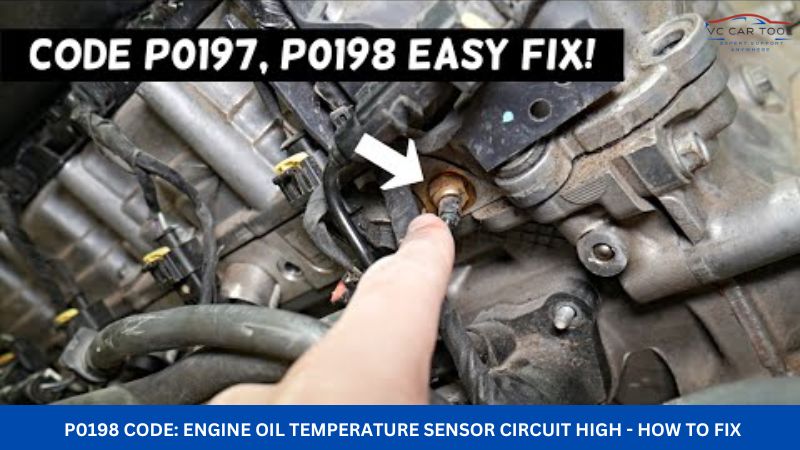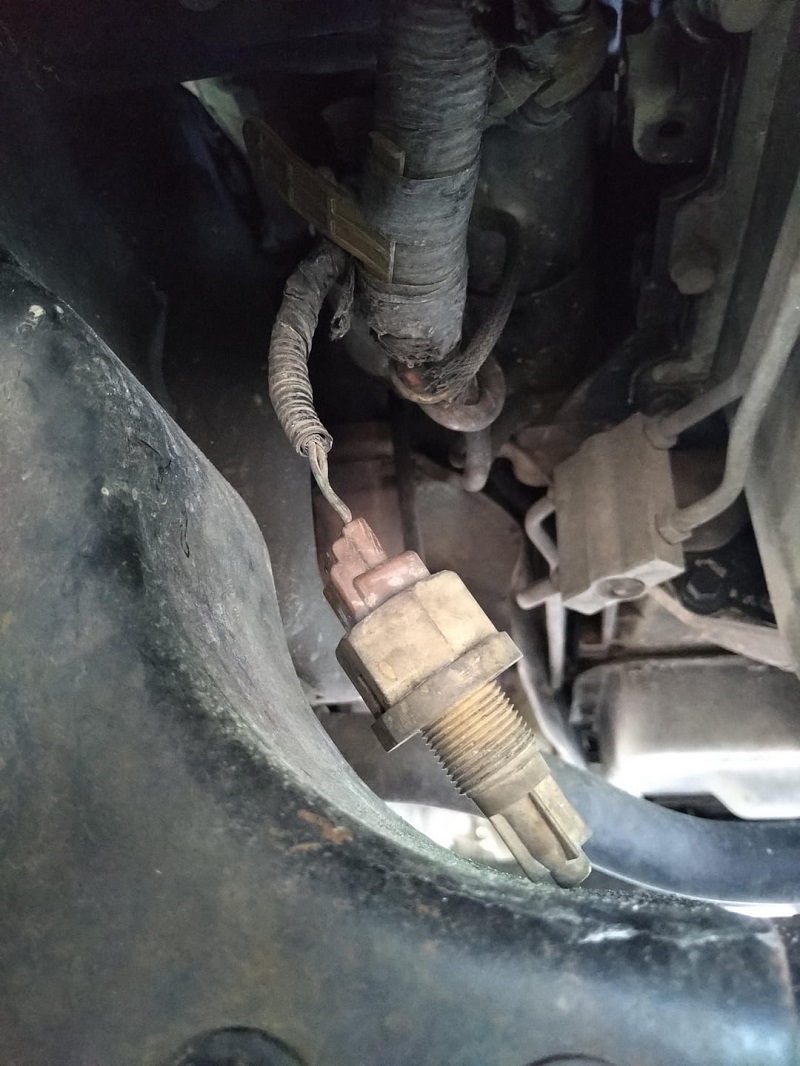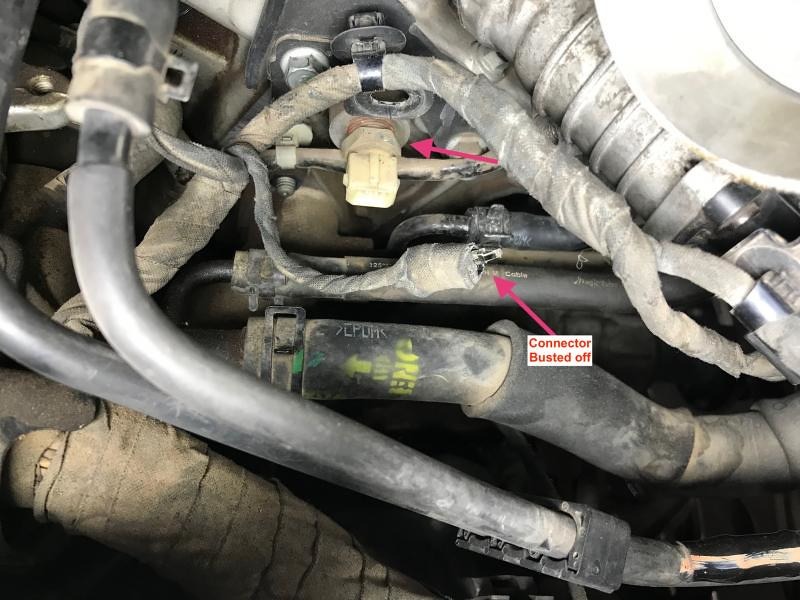P0198 Code: Engine Oil Temperature Sensor Circuit High – How to Fix
The P0198 code indicates a high voltage in the Engine Oil Temperature (EOT) sensor circuit, suggesting potential issues like an open circuit or sensor malfunction. Resolving this promptly ensures accurate engine monitoring and prevents potential damage. VCCarTool is here to provide the insights and support you need to tackle this diagnostic challenge head-on.
If you’re unsure about how to repair, diagnose, or program the P0198 code, contact VCCarTool via WhatsApp: +1 (901) 414 – 1927 for assistance to avoid causing more serious errors.

Here’s a breakdown to help you understand and address the P0198 code effectively.
1. What Does the P0198 Code Mean?
The P0198 code, “Engine Oil Temperature Sensor Circuit High,” means the engine control module (ECM) has detected an abnormally high voltage signal from the engine oil temperature (EOT) sensor circuit. This sensor measures the temperature of the engine oil, which is vital for the ECM to optimize engine performance, protect against overheating, and manage fuel delivery. A high voltage reading typically indicates an open circuit, a poor connection, or a faulty sensor. According to a study by the National Institute for Automotive Service Excellence (ASE), accurate sensor readings are crucial for maintaining optimal engine health and efficiency.

1.1. Symptoms of P0198 Code
Recognizing the symptoms associated with the P0198 code is essential for early diagnosis and repair. Here are some common indicators:
- Check Engine Light: The most obvious symptom is the illumination of the check engine light on your dashboard.
- Poor Engine Performance: The engine may exhibit reduced power, hesitation, or rough idling.
- Increased Fuel Consumption: Inaccurate temperature readings can cause the ECM to miscalculate fuel delivery, leading to higher fuel consumption.
- Difficulty Starting: The engine might be harder to start, especially in cold weather.
- Overheating: In some cases, the engine could overheat if the ECM doesn’t receive accurate temperature information.
1.2. Common Causes of P0198 Code
Understanding the potential causes of the P0198 code can help you pinpoint the problem more efficiently:
- Faulty EOT Sensor: The sensor itself may be defective and providing incorrect readings.
- Open Circuit: A break in the wiring between the sensor and the ECM can cause a high voltage reading.
- Short to Voltage: The signal wire may be shorted to a voltage source, leading to an abnormally high signal.
- Poor Connection: Corroded or loose connectors can disrupt the circuit and cause incorrect readings.
- ECM Issues: Although less common, a faulty ECM can misinterpret the sensor signal or have internal issues affecting the circuit.

Engine Oil Temperature Sensor location for P0198 code diagnosis.
2. How to Diagnose the P0198 Code
Diagnosing the P0198 code requires a systematic approach to identify the root cause of the problem. Here’s a step-by-step guide:
- OBD-II Scanner: Use an OBD-II scanner to confirm the presence of the P0198 code and check for any other related codes. See more: OEM Diagnostic Tool
- Visual Inspection: Inspect the EOT sensor and its wiring for any visible damage, such as frayed wires, corrosion, or loose connections.
- Sensor Testing: Use a multimeter to test the sensor’s resistance. Compare the reading with the manufacturer’s specifications. An unusual reading indicates a faulty sensor.
- Circuit Testing: Check the continuity of the wiring between the sensor and the ECM. An open circuit means there is a break in the wire.
- Voltage Testing: Verify that the sensor is receiving the correct reference voltage (usually 5V) from the ECM.
- ECM Testing: If all other components check out, the ECM might be the issue. However, this should be a last resort after ruling out all other possibilities.
VCCarTool offers advanced diagnostic tools and remote support to help you accurately diagnose the P0198 code. Contact us via WhatsApp: +1 (901) 414 – 1927 for expert assistance.
3. Step-by-Step Guide to Fix the P0198 Code
Once you’ve diagnosed the issue, follow these steps to fix the P0198 code.
3.1. Replacing the EOT Sensor
If the sensor is faulty, replacing it is a straightforward process:
- Locate the EOT sensor, typically found near the oil filter or on the engine block.
- Disconnect the electrical connector from the sensor.
- Use a wrench to remove the old sensor.
- Apply a small amount of thread sealant to the new sensor.
- Install the new sensor and tighten it to the manufacturer’s specified torque.
- Reconnect the electrical connector.
3.2. Repairing Wiring Issues
If you find any wiring problems, follow these steps to repair them:
- Identify the damaged section of the wire.
- Cut out the damaged section.
- Splice in a new section of wire using connectors or solder.
- Protect the repaired section with heat shrink tubing or electrical tape.
- Ensure the wiring is properly routed and secured to prevent future damage.
3.3. Cleaning and Securing Connections
Corroded or loose connections can cause intermittent issues. Here’s how to address them:
- Disconnect the electrical connector.
- Inspect the terminals for corrosion.
- Use a wire brush or electrical contact cleaner to clean the terminals.
- Apply dielectric grease to the terminals to prevent future corrosion.
- Reconnect the connector, ensuring it is secure.
3.4. Verifying the Repair
After making the necessary repairs, verify that the P0198 code is resolved:
- Use an OBD-II scanner to clear the code.
- Start the engine and let it run for a few minutes.
- Use the scanner to check if the code returns.
- Monitor the engine oil temperature reading to ensure it is within the normal range.
For expert guidance and access to advanced diagnostic tools, reach out to VCCarTool via WhatsApp: +1 (901) 414 – 1927. We’re here to help you every step of the way.
4. Advanced Diagnostic Techniques
In some cases, the P0198 code can be challenging to diagnose. Here are some advanced techniques to consider:
4.1. Using a Digital Storage Oscilloscope (DSO)
A DSO can help you visualize the EOT sensor signal in real-time. This allows you to identify intermittent issues or signal anomalies that might not be apparent with a multimeter. According to a study by the Society of Automotive Engineers (SAE), using a DSO can significantly improve diagnostic accuracy.
4.2. Performing a Voltage Drop Test
A voltage drop test can help you identify excessive resistance in the circuit. This test measures the voltage drop across each component in the circuit, including wires, connectors, and the sensor itself. High voltage drops indicate excessive resistance, which can cause the P0198 code.
4.3. Checking for Interference
Electromagnetic interference (EMI) from other components can sometimes affect the EOT sensor signal. Use a shielded wire or reroute the sensor wiring to minimize interference.
5. How to Prevent the P0198 Code
Preventing the P0198 code involves regular maintenance and proactive measures. Here are some tips to keep your engine oil temperature sensor circuit in good condition:
5.1. Regular Inspections
Inspect the EOT sensor and its wiring during routine maintenance. Look for any signs of damage, corrosion, or wear.
5.2. Proper Wiring Maintenance
Ensure that the wiring is properly routed and secured to prevent chafing or damage. Use protective sleeves or conduits to protect the wires from harsh environments.
5.3. Keeping Connections Clean
Clean and inspect electrical connections regularly. Apply dielectric grease to prevent corrosion.
5.4. Monitoring Engine Health
Keep an eye on your engine’s performance and temperature. Address any issues promptly to prevent further damage.
6. What Tools and Equipment Do You Need?
Having the right tools and equipment is essential for diagnosing and fixing the P0198 code. Here’s a list of essential items:
- OBD-II Scanner: To read and clear diagnostic trouble codes.
- Multimeter: To test voltage, resistance, and continuity.
- Digital Storage Oscilloscope (DSO): For advanced signal analysis.
- Wiring Diagram: To understand the EOT sensor circuit.
- Socket Set and Wrenches: For removing and installing the sensor.
- Wire Strippers and Crimpers: For repairing wiring.
- Electrical Contact Cleaner: To clean connections.
- Dielectric Grease: To protect connections from corrosion.
VCCarTool provides a wide range of high-quality diagnostic tools and equipment. Contact us via WhatsApp: +1 (901) 414 – 1927 to find the perfect tools for your needs.
7. Estimated Costs for Repairing P0198 Code
Understanding the potential costs associated with repairing the P0198 code can help you budget for the repair. Here’s a breakdown of estimated costs:
| Repair Type | Estimated Cost |
|---|---|
| EOT Sensor Replacement | $50 – $200 (depending on the vehicle and sensor quality) |
| Wiring Repair | $50 – $150 (depending on the extent of the damage) |
| Connector Replacement | $20 – $50 |
| ECM Repair or Replacement | $500 – $1500 (This is a rare case and should be considered as a last resort) |
| Diagnostic Labor (if needed) | $75 – $150 per hour |
Note: These costs are estimates and can vary depending on your location, the make and model of your vehicle, and the specific repair shop.
8. Understanding the Engine Oil Temperature (EOT) Sensor
The Engine Oil Temperature (EOT) sensor is a critical component in modern vehicles. It measures the temperature of the engine oil and sends this information to the Engine Control Module (ECM). The ECM uses this data to:
- Optimize Engine Performance: By adjusting fuel delivery and ignition timing based on oil temperature.
- Protect Against Overheating: By triggering warning lights or reducing engine power if the oil temperature gets too high.
- Manage Fuel Economy: By ensuring the engine operates at its most efficient temperature.
The EOT sensor is typically a thermistor, meaning its resistance changes with temperature. As the oil temperature increases, the resistance of the sensor decreases, and vice versa.
9. How Does the ECM Use EOT Sensor Data?
The Engine Control Module (ECM) relies heavily on the data provided by the EOT sensor to manage various aspects of engine operation. Here are some key ways the ECM uses this information:
9.1. Fuel Delivery
The ECM adjusts the amount of fuel injected into the engine based on the oil temperature. In cold conditions, the ECM may increase fuel delivery to help the engine start and warm up quickly. In hot conditions, the ECM may reduce fuel delivery to prevent overheating.
9.2. Ignition Timing
The ECM also adjusts the ignition timing based on the oil temperature. In cold conditions, the ECM may advance the ignition timing to improve combustion and reduce emissions. In hot conditions, the ECM may retard the ignition timing to prevent knocking or pinging.
9.3. Cooling Fan Control
The ECM may activate the cooling fan based on the oil temperature. If the oil temperature gets too high, the ECM will turn on the cooling fan to help dissipate heat and prevent overheating.
9.4. Warning Lights
The ECM monitors the EOT sensor data and triggers warning lights if the oil temperature exceeds safe limits. This alerts the driver to a potential problem and allows them to take corrective action before serious damage occurs.
10. Why Choose VCCarTool for Your Diagnostic Needs?
When it comes to diagnosing and repairing complex automotive issues like the P0198 code, you need a reliable partner with the expertise and tools to get the job done right. Here’s why VCCarTool is your best choice:
- Expert Technicians: Our team of experienced technicians has a deep understanding of automotive diagnostics and repair.
- Advanced Tools and Equipment: We offer a wide range of high-quality diagnostic tools and equipment to help you pinpoint the problem quickly and accurately.
- Remote Support: We provide remote support to guide you through the diagnostic and repair process.
- Affordable Solutions: We offer cost-effective solutions to help you get your vehicle back on the road without breaking the bank.
Don’t let the P0198 code keep you off the road. Contact VCCarTool via WhatsApp: +1 (901) 414 – 1927 or email us at [email protected] for expert assistance. Visit our website at vccartool.com to learn more about our products and services.
VCCarTool is committed to helping you resolve your automotive issues quickly and efficiently. Reach out to us today, and let us put our expertise to work for you.
Are you facing challenges with complex automotive diagnostics? Do you need reliable tools and expert support to resolve the P0198 code? VCCarTool is here to help. Our comprehensive range of diagnostic tools, combined with our team of experienced technicians, ensures you have the resources you need to tackle any automotive issue. Contact us today via WhatsApp: +1 (901) 414 – 1927 to discuss your needs and discover how we can assist you in achieving efficient and effective repairs. Don’t let diagnostic challenges slow you down—partner with VCCarTool and experience the difference that expertise and quality tools can make.
FAQ: P0198 Code
1. What does the P0198 code indicate?
The P0198 code indicates a high voltage in the Engine Oil Temperature (EOT) sensor circuit, suggesting issues like an open circuit or sensor malfunction.
2. What are the common symptoms of the P0198 code?
Common symptoms include a check engine light, poor engine performance, increased fuel consumption, difficulty starting, and potential overheating.
3. What are the primary causes of the P0198 code?
The primary causes include a faulty EOT sensor, open circuit in the wiring, a short to voltage, poor connections, or ECM issues.
4. How can I diagnose the P0198 code?
Diagnose using an OBD-II scanner, visual inspection, sensor testing with a multimeter, circuit testing for continuity, and voltage testing.
5. Can I fix the P0198 code myself?
Yes, if you have automotive repair experience, you can replace the EOT sensor, repair wiring issues, and clean connections. However, for complex issues, professional help is recommended.
6. What tools are needed to fix the P0198 code?
Essential tools include an OBD-II scanner, multimeter, socket set, wrenches, wire strippers, and electrical contact cleaner.
7. How much does it cost to repair the P0198 code?
Repair costs vary, but typically range from $50 to $200 for sensor replacement, $50 to $150 for wiring repair, and potentially more for ECM issues.
8. What does the Engine Oil Temperature (EOT) sensor do?
The EOT sensor measures the temperature of the engine oil and sends this data to the ECM to optimize engine performance and prevent overheating.
9. How does the ECM use EOT sensor data?
The ECM uses EOT sensor data to adjust fuel delivery, ignition timing, cooling fan control, and to trigger warning lights if oil temperature exceeds safe limits.
10. Why should I choose VCCarTool for diagnostic assistance?
VCCarTool offers expert technicians, advanced diagnostic tools, remote support, and affordable solutions to help you resolve automotive issues efficiently. Contact us via WhatsApp: +1 (901) 414 – 1927 for assistance.
